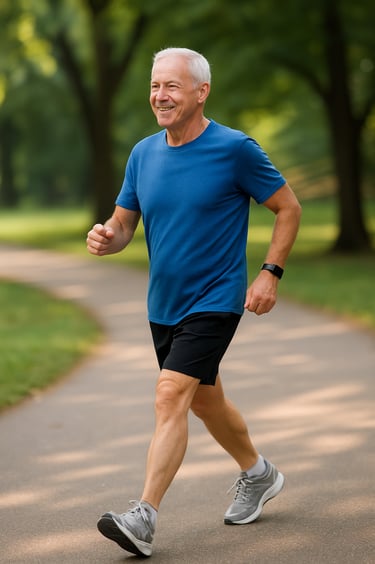Walking Faster = Living Longer: The 14-Step/Min Longevity Boost
Just 14 extra steps per minute may strengthen mobility, fight frailty, and boost longevity. Learn how to walk faster smartly after 60.
Bruce R Black
10/16/20252 min read


Hey you — yes, you with the comfy shoes and the “I’ll walk later” habit. What if just 14 extra steps per minute could boost your health, strength, and lifespan? That’s what new research is hinting, and it’s too juicy not to explore.
Brisk walking is already a favorite in longevity circles, but this new twist gives us a concrete, manageable “speed hack” to test. Let’s dive in.
What’s the 14-Step/Min Study All About
A recent trial published in PLOS ONE (via Medical News Today summary) recruited older adults (60+) in a retirement community, including those who were prefrail or frail. (Medical News Today)
Participants were split into two groups:
Normal pace walking
“Faster walking”: roughly 14 extra steps per minute over their usual tempo.
By the end, the “faster walkers” showed measurable improvements in physical function — strength, mobility, balance — compared to the control group. These gains may translate into better longevity, less frailty, and a more resilient you. (Medical News Today)
If boosting your walk by just 14 steps per minute is enough to move the needle on aging, that’s something many of us can do (without getting out of breath or doing burpees in the snow).
Why Walking Speed Matters for Aging & Survival
Walking speed has long been viewed as a “vital sign” in gerontology. Slower gait tends to correlate with risk of mortality, cognitive decline, and frailty. (PMC)
In one classic study, gait speed predicted 10-year survival as well as age, chronic disease, blood pressure, BMI, and other risk factors combined. (PubMed)
Older adults whose walking speed declines rapidly (fast decline trajectories) had ~90% greater mortality risk vs. those with slower decline. (PubMed)
The 14-steps/min approach gives us a practical lever — a small but targeted increase that is easier to adopt than a sweeping fitness overhaul.
In short: walking faster may not just reflect better health — it may cause improvements in health over time (though the causality still needs more research).
How This Applies to Active Agers & Seniors
If you’re 60, 70, 80, or just wise beyond your years — this is for you. Here’s how to use this “14 extra steps” insight without wrecking your joints or stamina:
Measure your baseline cadence. Use a pedometer, fitness tracker, or count steps for one minute during a regular walk.
Add ~14 steps per minute. If your usual is 80 spm (steps per minute), aim for ~94 spm on some segments.
Don’t overdo it. Try small bursts: maybe 1–2 minutes faster, then ease down.
Mix it in. During stronger walking days or longer walks, use those bursts.
Maintain strength & balance. Walking faster is great, but muscles + mobility keep you upright and efficient.
Over time, if you consistently push your cadence upward, your vascular health, muscle fibers, balance, and perhaps even brain health get nudged upward too.
Sample Week Plan
If doing the bursts feels easy, you can gradually extend duration or increase frequency — just stay comfortable and joint-sound.
Walking Faster = Living Longer: The 14-Step/Min Longevity Boost
Beat Age With Ease
Empowering seniors to achieve fitness and health.
© 2025. All rights reserved.
"Disclaimer: The fitness and exercise information provided on this website is intended for educational purposes only. It is not a substitute for professional medical advice, diagnosis, or treatment. Consult your physician or a qualified health provider before starting any exercise program. The use of any information provided on this site is solely at your own risk. We do not assume liability for any injuries or health issues that may result from using our content."
💛 Found something helpful? Sharing is free, but if you’d like to keep the lights on and the ideas flowing, you can buy me a coffee below.
